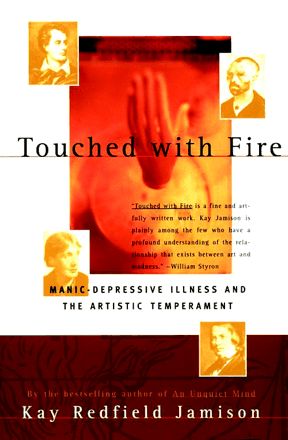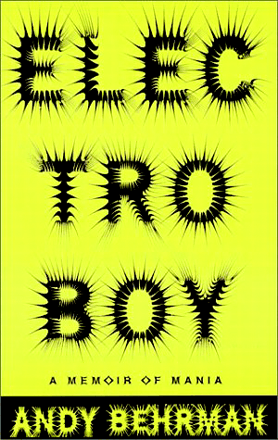A Fire in the Mind

Electroboy: A Memoir of Mania . Andy Behrman. New York: Random House; 2002. 288 pages. $24.95 ISBN: 0375503587
Bipolar disorder is characterized by marked changes in mood, swinging from phases of elevated mood, irritability, and sometimes frenetic activity, to despairing depressions occasionally so severe that thoughts of suicide are strongly contemplated. The inability to predict when such states might occur or how long they will last would seem agonizing enough. Nonetheless, there are those who contend that a significant number of highly regarded authors and painters suffered—and benefited—from bipolar disorder. Indeed, the premise of Kay Redfield Jamison’s excellent Touched by Fire is that bipolar disorder, as exploited by the artist, may be responsible for the difference between well-regarded output and works of genius. That is, bipolar disorder enables the artist to bridge the chasm between ordinary and extraordinary.
The reckless nature of manic episodes, the uninhibited thoughts and outbursts, the abandonment of restraint, and standing boldly resolute with confidence instead of uncertainty may lead the artist to see as the oracle sees. The poet John Berryman suffered from bipolar disorder—it eventually claimed his life through suicide—but strongly argued that the ordeals imposed by the disorder made him a better poet, stating that, “‘The artist is extremely lucky who is presented with the worst possible ordeal which will not actually kill him. At that point, he’s in business.’” John Keats put it more beautifully: “‘…I leaped headlong into the Sea, and thereby have become acquainted with the Soundings, the quicksands, & the rocks, than if I had stayed upon the green shore, and piped a silly pipe, and took tea & comfortable advice.’”
Yet, when the pendulum of the disorder swings to its opposite, depression, too, is said to add to the creative process. If mania produces outbursts of raw creation, then depression, according to Redfield, acts as an inward-gazing editor. By pushing and stretching himself, aided by mania and periods of depression and lucidity—a sort of emotional process of excited rough-draft writing and stone-sober revision—the artist’s work arrives in an undiscovered land of creative genius. Vincent van Gogh wrote: “‘The more I am spent, ill, a broken pitcher, by so much more am I an artist—a creative artist…’” Theodore Roethke: “‘In a dark time, the eye begins to see.’” And again Keats: “‘Do you not see how a World of Pains and troubles is to school an Intelligence and make it a soul?’” Depression promotes clarity and aids the generative process of genius by sieving the crude from the fine. Thus, learning and practicing one’s craft is necessary, but life experiences (including tortuous mental states) foster uncommon creativity by a process of life reflection, quest for meaning, and hope for redemption and validation.
In addition to casting an illuminating glow on creativity, doesn’t a fire in the mind require occasional suffocation? Some artists may be more interested in helping themselves through self-expression than concerning themselves with pleasing a critical public. For example, art therapy is frequently utilized as an instrument for psychological exploration and as an outlet for unspoken pain. Hector Berlioz thought that if he did not compose music he would go completely mad. Only through composition could he satisfy his “‘immense appetite for emotion.’” Redfield quotes Lord Byron on writing poetry as mental salvation: “It is the lava of the imagination whose eruption prevents an earth-quake—they say that Poets never or rarely go mad …but are generally so near it—that I cannot help thinking rhyme is so far useful in anticipating & preventing the disorder.” T.S. Eliot described it this way: “‘Poetry is not a turning loose of emotion, but an escape from emotion.’”
Although bipolar disorder wreaks havoc beyond the lives of those who suffer from it (including families and friends), artists in particular, according to Redfield, appear to worry whether drug treatment would hamper their creativity, “‘transform[ing] them into normal, well-adjusted, dampened and bloodless souls—unable, or unmotivated, to write, paint, or compose.’” Movie director David Lynch gave up on psychoanalysis because he was told it might affect his creative output. It is well established that bipolar patients report that their emotions feel flat and that they miss their mild euphoric (hypomanic) states. Indeed, the loss of euphoria is primarily why patients become noncompliant. On the other hand, poet Robert Lowell—whose manic exploits are quoted in several places in Touched with Fire —after successful treatment with lithium observed: “‘It’s terrible…to think that all I’ve suffered, and all the suffering I’ve caused, might have arisen from the lack of a little salt in my brain.’”

Indeed, a harrowing personal account of the daily life of a manic-depressive is detailed in Electroboy: A Memoir of Mania . Andy Behrman’s diary immediately ensnares the reader and leaves him breathless with a vivid tale of devil-take-the-hindmost mania characterized by hypersexuality, consumer purchasing that would make Imelda Marcos envious, a need to be anywhere-but-here at any cost, and depression typified by grave melancholy and later, delusions and hallucinations. His symptoms get worse over time with little abatement, and the medications he takes work for only a little while before needing to be recalibrated. After undergoing nineteen electroconvulsive therapies, his doctor miraculously concocted a drug regimen that keeps him on the knife’s edge of sanity. Even taking an over-the-counter drug to fight the symptoms of a cold once sent him into a hallucinatory nightmare. The book’s most succinct irony? The photograph of the author in front of a billboard advertising peauts that sums up the life of Andy Behrman: “Relax. Go nuts!”
“It’s 4:30 a.m. There’s cash on every piece of furniture and I’ve gone for almost two days without sleep. I’ve been drifting
between bars, clubs, and parties on drug and alcohol binges. Exorbitant meals and casual sex with anonymous partners fill
my late nights. I’m as committed to my binges as I am to my daily workouts with my trainer. I’m living in hotel rooms on a
diet of tofu and tuna fish, dodging creditors and shoplifting. $25,000 shopping sprees at Barneys are my weekend diversion.
Impetuous trips to Paris, Milan and the Caribbean are the perks of my success. I’m traveling faster than humanly possible.
I’m manic and I can’t step on the brakes.”

- © American Society for Pharmacology and Experimental Theraputics 2002



